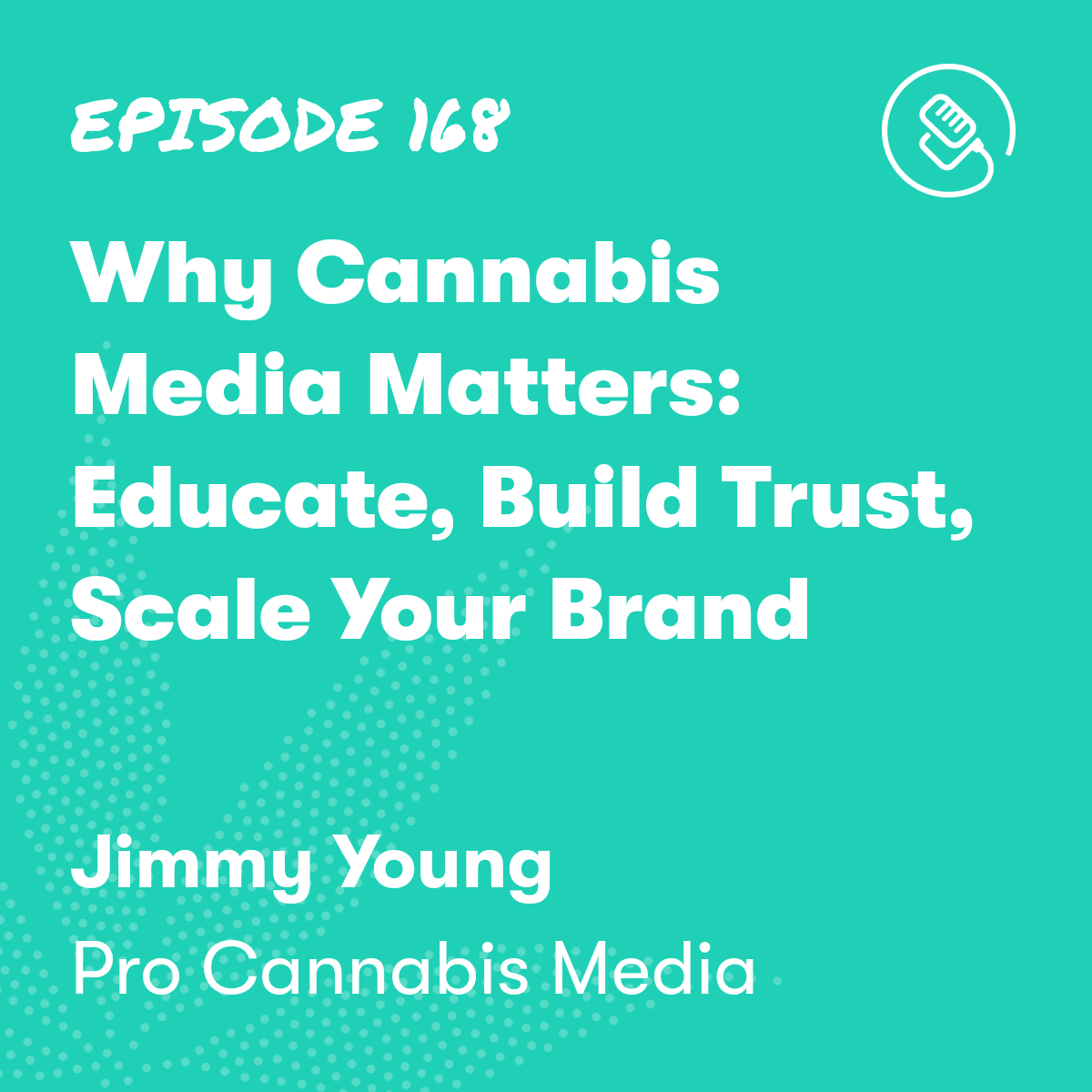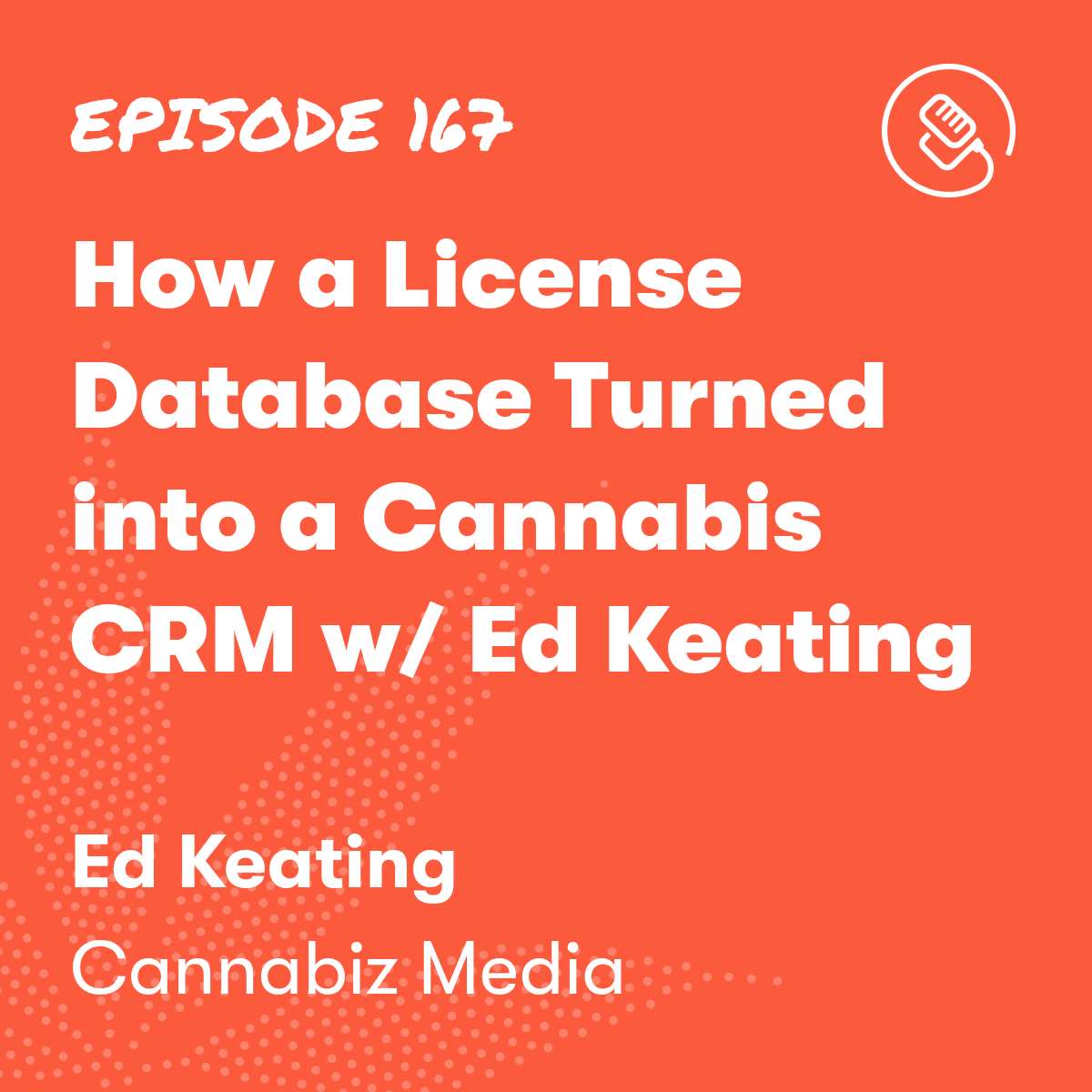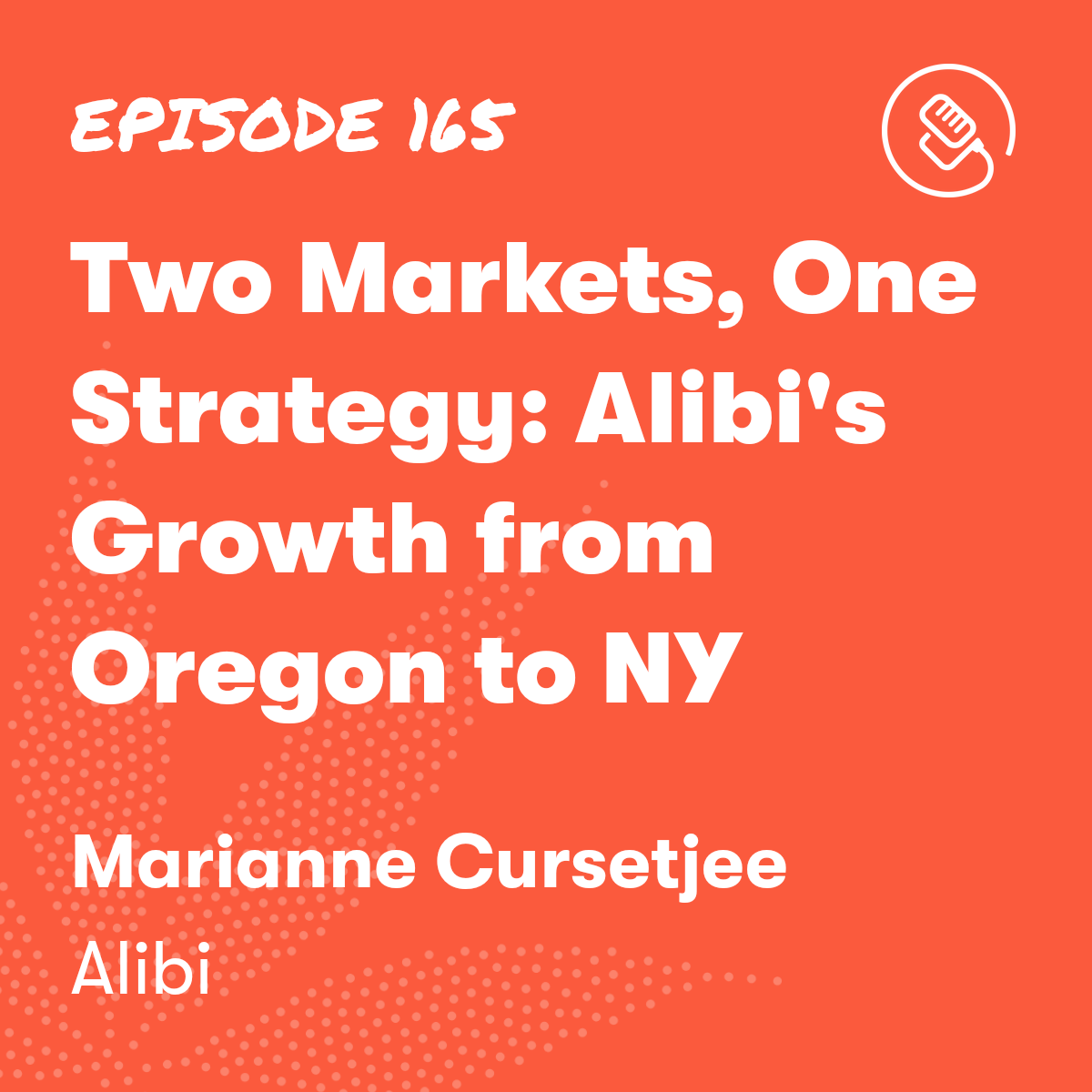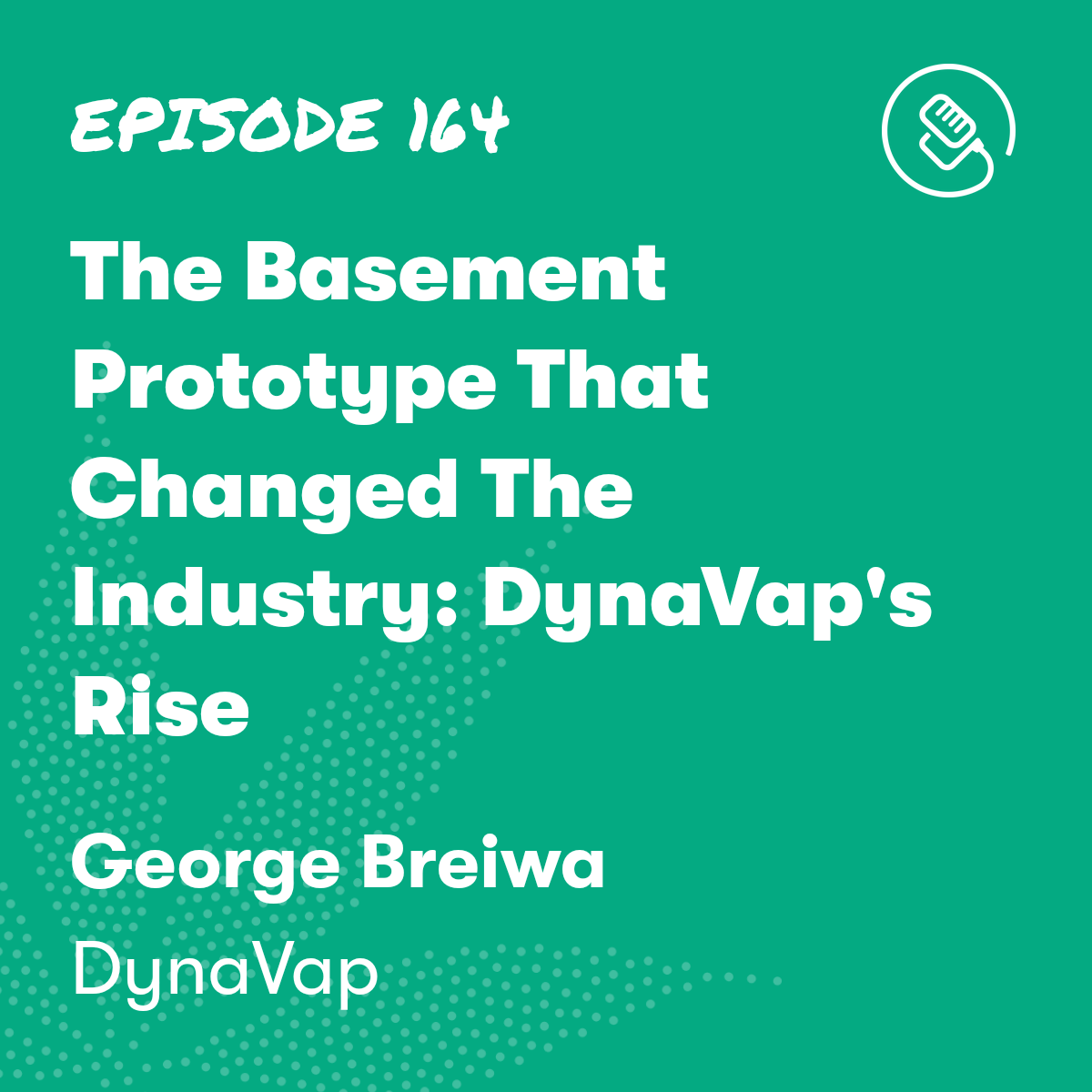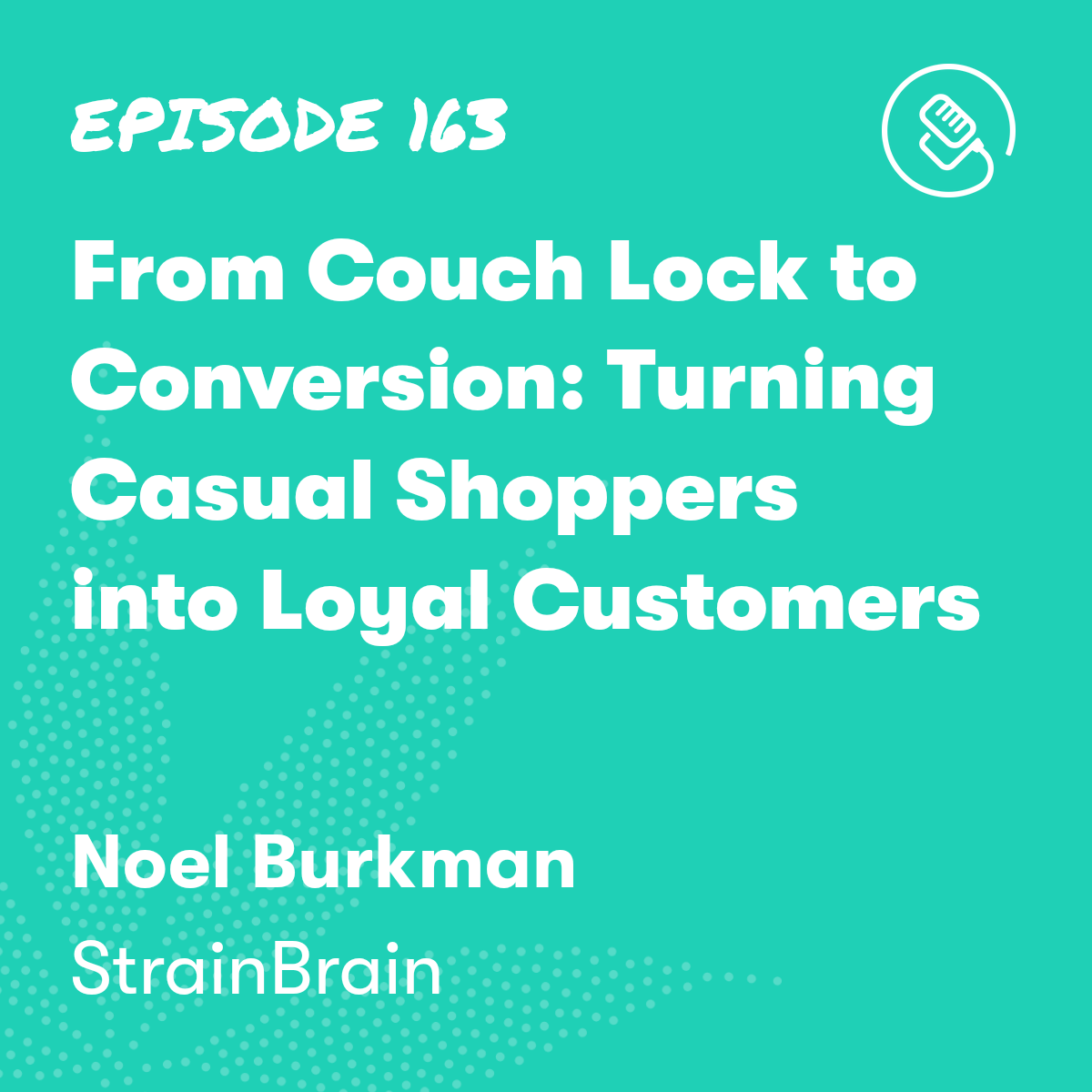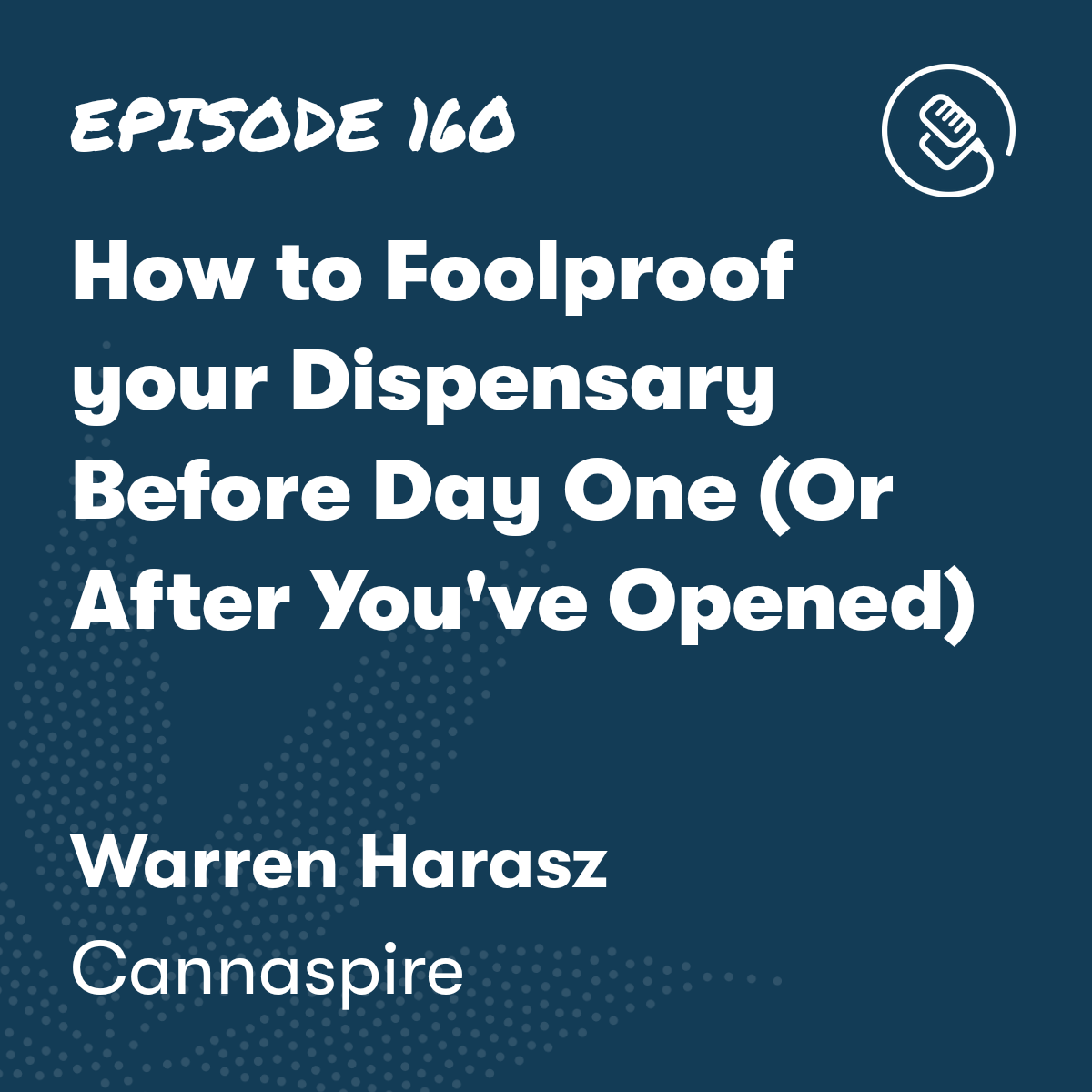

Weeding Out Risk: Asset Protection in the Cannabis Industry
Episode Description

Episode Transcript
Tommy: Hey everyone. In this episode, we are joined by Jeff Bartley, the Senior Risk Consultant at Sapphire Risk. Jeff has over 20 years experience helping high risk retail environments protect our assets. In this episode, Jeff gives us advice on how to protect your cash and inventory, as well as employee training. If you have high risk assets like cash and inventory, which I know you do, this episode is for you. I hope you guys enjoy.
What are the high risk areas in the cash management process?
Jeff: So the high risk area is the sales floor and the vault, right? You want to make sure that you have two party verification anytime the vault is touched.
Anytime there's, you know, the safe is open, there needs to be to make sure there's camera and oversight of who's going in it and what for. From a sales floor perspective, it's ensuring that you manage and maintain cash levels. And that employees are understanding their role in the process that, you know, this is my cash register.
I'm responsible for the variance that [00:01:00] happens at night. I'm going to count it when I come in and make sure that it's supposed to be what it's supposed to be. When we leave at night, I'm going to be there when it's counted. So that I understand that the, you know, if I don't count it myself in front of someone else, but that two party verification is crucial.
Tommy: So anytime cash is counted, there should be two people.
Jeff: Yeah, that's, that's our recommendation. There should be two party verification. And you want to do it, uh, out of sight of customers.
You want to do it, you know, you don't want to do it in front of a window at night. I I've seen it happen where they're like, well, there are no customers in the store. Yeah, but people can still see in, you know, and if they see a large stack of cash on the counter, it all goes back to that mitigating risks.
Right. What risk are you comfortable with? So get it out of customer view, get it back in the back room, in the vault, and always make sure that there's, you know, when possible, and I have to stress when possible, that there's somebody else to be present to ensure the accuracy and validity of the account.
Tommy: This is a cash business and oftentimes dispensaries pay vendors by cash. What are the best practices when [00:02:00] taking money out of the vault and paying a vendor?
Jeff: So it all goes back to that, um, what's the word I'm looking for, that Data justification, that everything that happens is on paper, that there's more than one person signing off in a grant that says, and sometimes it's the management signing off, it's the vendor signing off, and then maintaining a receipt of those records, being able to show the paper trail of where it went from here to here, to here, to here.
That way in the event, there's ever a, an inquiry or a questionable content. There's more than just one person side of the story. You've got video to back it up. You've got paperwork to back it up. You have multiple parties that have been involved during that transfer.
Tommy: When should cash from the bulk be counted?
Jeff: How often the cadence to that truthfully can kind of be decided by each individual dispensary. We recommend nightly verification. I mean, you want to know when you open the business that the cash that's supposed to be in the store is the amount in the store. When you close the business, you want to make sure, or twice a day I should say, you want to [00:03:00] make sure that the cash in the store equals the cash that it's supposed to be.
So twice a day is what we would recommend. Now, I have heard of SmartSafe, so there are some other things, uh, that dispensaries can invest in that takes a lot of that out of their hands. It's time saving, those usually have a little higher cost, so it takes a little longer to get your return, uh, but if you're using a straight safe that you're going in and out every day twice a day.
And then what happens if you counted it and there's a discrepancy either over it, you know, there's more money than you thought? You should have more or less money.
That's when they need to start doing their investigation to determine what happened, where the error took place. And having an appropriate cash management program in place can help point that out.
Because you'll know if somebody's over assured individually, if it's been their cash drawer before you ever get to the close at night. If you have a good cash print management program in place that's executed to process, And all of the cash drawers come out [00:04:00] front, and at the end of the night, there's a variance.
Then you know that it happened at the management level, and it helps then reduce the amount of time spent in an investigation. And you can find out, was it a vendor payment that wasn't processed, or was it, a refund that wasn't properly processed. And it just kind of helps invade that, uh, excuse me, it helps improve that investigative piece, so that you're not spinning wheels and, and direct your focus as you're trying to find out what caused the variance.
From a reporting standpoint, each company can customize whatever that dollar amount tolerance, if it's a couple of cents, most companies, it's just not worth their time to investigate a couple of cents. If it's a couple of hundred dollars, there should be a notification program that goes to a district manager or ownership that, Hey, we've got some problems here tonight.
We might need you to help come find. Where this discrepancy took place.
Tommy: So based on what you, based on your experience, what is normal? What is a normal variance and how often does normal happen?
Jeff: A couple of cents. And it happens more often. What I found in [00:05:00] dispensaries is, uh, for the most part cash management, the, the, I shouldn't rephrase that, cash variance, uh, it's pretty good.
When you start to have an issue in a store, it's. It's always internal. It's always internal. Um, I don't know, and I'm not, I shouldn't say always. How about I've never been involved in an investigation where it wasn't internal, right? And they're usually pretty easy to find, pretty quick. And there are, companies or some internal policies that stores can do to help interview that employee, determine, you know, the reasons behind it.
And, and, and in a lot of instances, even Provide some recovery in terms of vault access, who should have access to just management and just manage. Yeah. Store management, senior leadership ownership. We're a big believer in, uh, that even the vault should be verified by a store management supervisor, [00:06:00] you know, on a random cadence.
You don't want to say once a month on the 5th of every month, we're going to come in and check your vault. It doesn't make sense, it needs to be random intervals, random times where senior leadership comes in and says, you know, your vault's supposed to have 25, 000 in cash on it, let's count it right now and make sure you don't have somebody floating deposits or any of the other things that are common.
Tommy: Does everybody, should everybody have a different PIN number to access the vault?
Jeff: Depends on the safe that they have. I think that if everybody has an individual PIN number, then it's easy to track who's in the safe and who's not. If there is a single combination to the safe. Then that safe should be assigned to a single individual every day.
So, when that person comes in and they sign off and say, I counted the safe, it's what it's supposed to be. That's their safe throughout the day. They're the ones responsible for the money coming in and going.
Tommy: So, that, so that pin changes day by day then?
Jeff: It can, we don't recommend it. It can get pretty tedious.
It, I mean, normally most safe combinations, that's the [00:07:00] safe what it is. Now, what is important is anytime you then have management turnover, It's important to immediately update and change the safe combination so that, you know, they can't come in later on down the road and say, oh, it's the same code it was when I worked here.
I mean, that's a really good point. Wonderful locks like front locks, I'm guessing alarms. Yeah, and it all goes back to anytime you lose leadership, there's actually a, a set process of everything that you should update. Access codes, pimm codes to doors, uh, safe combinations. Um, if you provide remote access to your video surveillance system, that's removing them from that.
I mean, there's a, a laundry list of things if you separate management that you really need to go through almost immediately. And say, okay, we need to make sure that they've removed all access to our business that we've provided.
Tommy: So, I'm guessing that's part of the SOP that you guys roll out.
Jeff: Yeah, that should be part of their standard operating procedure anytime there's turnover, intentional or not, you know.
Um, some, uh, [00:08:00] dispensaries provide bud tenders access to different controlled areas. Uh, they don't, I don't know of any that provide them access to the vault, but they may be able to provide access to, you know, a merchandise stock or some other things as well. If bud tenders have access to PIN controls that allow access to those stores, those should be changed as well.
Tommy: How often should SOPs be revisited?
Jeff: That is a great question, Ian. It's something that, you know, in the industry, we honestly recommend an annual review of your processes. And the reason that we recommend that is one, neighborhoods change, right? Business trends and technology change. The execution of store level, your employees change throughout the year, and you may find something that you were doing that worked a year ago just doesn't make sense in your current environment.
So an annual review, kind of helps provide that report card and tell the business, this is where you think you're at, here's where you're at, and to [00:09:00] determine where they match. Where they don't match so that they then can develop a plan to help them be successful in the next step.
Tommy: So how does a business owner audit their existing SOP?
Like what are the steps involved to know, hey, is this a
Jeff: So the first step is know what they are, right? As a business owner, you need to know what the expectation. the second piece then is, To audit it. And there's a number of ways they can do that through secret shops. Uh, they can hire outside consultants. they can hire, you know, senior leaderships to, you know, secret shop and go in and see, uh, friends and family. You know, there's, there's a number of different methods and varieties for them to go in and see what are employees doing that they're supposed to be doing.
If they're doing it a little more administration, administerially, is that even a word? I don't know. Anyway. If they're looking at it more from a paperwork perspective, then I would recommend getting an outside consultant. Get somebody who's been in the business to take a look at it and say, you know, this takes a whole lot of time, costs you X amount of dollars.
If you did it this way, you [00:10:00] could save a little bit.
Tommy: Can you leverage? Can you leverage security cameras to do an audit?
Jeff: Oh, you absolutely can. Yeah, there are a number of great video surveillance systems that are out there. That whenever an employee conducts a transaction, you can physically go in and it'll pull up the receipt of the transaction and the video 10 seconds before and 10 seconds after. I mean, it's not something that has to be done through an outside consultant.
You can use video surveillance to do it if you have the right surveillance processing system in place. And those are usually a little more expensive than, you know, some of the, uh, I guess I'll use the term older technology that's available in the space right now.
Tommy: Have we covered everything that we should cover from a cash management perspective?
Is there anything else that you
Jeff: Not from cash management. I think we're good there.
Tommy: So what are, what are some of the items that a business owner should think about that we haven't spoken to about cash management?
Jeff: So when we go back to [00:11:00] that training piece, Training is so important at the employee level for a number of different reasons.
And I mentioned some of those earlier. It's about letting them know that the company cares. It's about providing that investment. But most employees that come into your business, they don't come in with the expectation or the desire to be a budget or the rest of their life. They want to move up. They want to go on.
They want to develop. They want to learn. So they can, can continue to grow there. And the type of training that gets provided needs to be that career motivating, that career building training. So even with safety and security, I mean, there are levels of training that you can provide that are going to help employees in the future down the road.
And it doesn't just have to be safety and security. It's any training, right? Like, Hey, here's how you, you know, here's how you provide good performance reviews. Here's how the difference between coaching and, and, and management, [00:12:00] right? The difference between a leader and a manager.
Training these days isn't what it was in the old days. Training used to be, here's how you run a cash register. Here's how you process a sale, right? And now it can be things like, here's how you manage your time, right? Here's how you develop and set a goal and then create a step by step guide to help you achieve those goals. Those are concepts and that employees can take. Wherever they go, not just in the cannabis industry and those have impacts and you're trying to teach me to be a better, you know, employee globally, not just within the space.
Tommy: You made such an insightful comment about the importance of tying in an employee's long term goals with what the business needs.
That's so insightful
What can a company do to make sure employees care? Why shouldn't an employee care about following some crazy procedure rules? If it doesn't really impact them.
Jeff: Ha ha ha ha ha ha. [00:13:00] Ah, why should an employee care?
Tommy: But then you, you made something, you said something that's so insightful.
Because, you're not really just teaching an employee. To follow these rules. Right. You're building the foundation for their future. And if they understand the inner workings of how a dispensary is run, the infrastructure for security, they can take that with them to their future career.
I want to pivot a little bit and talk about inventory management. We covered cash, cash is a high risk item. Inventory. Yeah. Yeah. What are the tenets of a strong inventory SOP?
Jeff: So it starts with an audit cadence, it's developing and understanding what your most desirable product is, identifying what product is loose, what product is not, right?
And then developing a cadence of constant reinforcement that what you're supposed to have on hand is on hand. It's ensuring that you've got a good waste program. It's ensuring that, the counts that are being done aren't always being done by the same person. It's [00:14:00] providing that. It has a random element to it to ensure the integrity of the verification process being done.
It's ensuring that we're receiving product well, right? You know, if the invoice comes in, that we're responding quickly to that. It's also ensuring that we are reporting regulatory compliance to metric or biotrack or whatever, uh, regulatory system your particular state uses. To ensure that if there ever is any kind of issue, you know, say power goes out, right, you can't always necessarily, are you using a POS system that as soon as power is restored, it's going to instantly communicate those inventory changes to those bodies as well.
Um, it also encompasses, you know, the training of the employees of what that program is. Audits are great at catching for things that already happen, but at that point it's already happened. You want your inventory management program to be preventative, to be proactive. So by letting the employees know that [00:15:00] all of these steps are in place, when they come on board, may then keep those people that are on the fits, on the bright side, on the good side, from doing something that could ultimately impact their life so you've got to be able to communicate that program with the employees when they come on. So what are the areas of risk?
So, the biggest risk is that internal theft piece, 95, 90 to 95 percent of all retail businesses right now are still experiencing internal risk. It's their number one loss because it's such a desirable product. It's cash, it's drugs, you know, it's, it's, it's hard to resist. And. You know, there's, there's an old adage in loss prevention called the fence rule.
Um, you know, uh, what is it? 10 percent of the people on the planet, you know, will always do the right thing no matter what. 10 percent of the people on the planet will always do the wrong thing no matter what. The other 80 percent are what we call on the fence. And depending on The, the, the important factors of making decisions, opportunity, [00:16:00] right?
Rationalization, need or greed, provided all of those pieces are kept on, you can save yourself those other 80 percent by keeping them on the fence, right?
Tommy: So what are strong offering procedures that prevent that?
Jeff: So it, it goes to things like daily cycle counts, you know, the, the high desire stuff, are we counting them every day?
Do we keep an on hand quantity enough where that's feasible? , it's things like, regular full audits where we conduct full audits on every piece of merchandise. How often should that happen? So generally once a year is acceptable, uh, in some cannabis instances, depending on the sheer volume of product, you might want to do it twice a year.
I've actually been to some dispensaries that are doing it quarterly because they've got lower on hand quantities of product. What it all boils down to is the more, the, the higher frequency with which you conduct your inventories, the better grasp you have of what's in your store. So I know that a full audit [00:17:00] takes a lot of time.
Can, yeah. It can. Yeah. What is the, in your view, what is the right cadence for an audit? Maybe not a full audit. Maybe you're auditing different SKUs, maybe you're auditing different products, how often should that happen? Yeah,
I think it should be a two pronged approach.
I think that, you know, throughout the week, you should pick a certain category to do what we would call a cycle count. Where, you know, like on Tuesdays, we're just going to count, you know, flower. Or on Wednesdays, we're just going to count, you know, tink shirt. Um, and every day of the week you do a smaller portion and you do it with a frequency and it may be a two week cycle depending on the sheer volume of products that you count, but, but regular counts every day.
You want your employees to know that we're looking at something every day to limit their thought process of opportunity. I see from a full audit standpoint, you know, I go back to whichever you're comfortable with at a minimum, once a year, the more, the better. Uh, but those can be, you know, like I said, depending on the volume of [00:18:00] product, there can be some employee, you know, labor costs involved where it may not be feasible for some of the smaller, smaller operators.
Tommy: What are the tenets of an effective inventory account, like what should be in place?
Jeff: Okay. So what it should start with is one, it should be able to provide you with live results. Meaning if somebody sells something, it should be able to update right away so that you know, you're not going to count.
Two, it needs to be able to tell you once you've entered account, I don't believe it should tell you how many you should have on hand first. I believe that you should be able to count it and say, I have X amount. And then when you input the number, it tells you the variant. Because if it tells you, you should have 28, an employee looks at that 28 number, they're going to keep counting and counting and counting until they get to 28.
And they may count the same piece twice, right? If they're doing it blind and they're just saying, okay, well, I count 23 and they entered the number and they're like, oh, I'm supposed to have 28. That's a little more eyeopening. You're going to get a little bit more accurate result. Human error is always there.
It's tough to fight. And by doing it blind. It's a lot easier to ensure [00:19:00] you get in there.
Tommy: If you, if we do an inventory count and there's a discrepancy, what is the SOP to figure out what happened?
Jeff: And yeah, and that's really, it's up to each owner to develop their investigative process. ultimately there's not a state I'm aware of where you don't have to communicate it within 24 hours.
If you cannot find the discrepancy within 24 hours, it needs to be communicated to the regulatory body. But each dispensary is up to determine their own investigative process of what that looks like.
Tommy: And from your experience, what is normal?
Jeff: So what is normal is first it starts with, okay, let's check shipping, let's check receiving and transfers and shipments first, right?
Let's check waste, that's second, right? And then it's, let's look and see, let's say it's a daily count. You know, do we have a cash register that's over that matches the dollar amount sold of the product that we're missing? So there are some steps that go to it. And if you, if you ultimately can't find it, then it comes down to reporting.
And that's when you kind of get upper management involved and start doing a little [00:20:00] bit more spot checks, uh, you know, camera reviews, things like that, to review transactions. And you may then increase the cadence in which you're counting whatever particular product that it is that you're missing to try to identify some key trends and factors that might point you in the direction of the root cause.
Tommy: When you're doing an inventory account, should it be dual? Two people are present or does it matter? Should it be what? Should two people be present during an inventory account or does that, does that matter?
Jeff: Um, I don't necessarily know that two people need to be present as long as it's not the same person two times in a row.
Yeah, you want to make sure that it's, it, it varies from person to person to ensure the integrity of the account. And do
you restrict the same people in the same shift or is there, is there, you know, standard operating procedures where it'll be the morning person doing account and that morning person maybe doesn't work with the evening person and they do account of the same product.
Yeah. You want to provide as much variability as you can into your [00:21:00] account SOP to ensure its integrity two people who are constantly working together, going back and forth on the counts. If you can alter that and break that up to two people who may not know any better, it all goes back to them.
What I keep saying is protecting that integrity. You want to make sure that the counts that you're getting are accurate so that you as a business owner can respond appropriately in the event of variance does occur.
Tommy: What happens if you find that It is employee, but you don't know which employee
Jeff: That is the tough part because then you're looking at investigations and you have to be careful not to fall into the accusatory trap, right? You've got to make sure that anything that you do is factual base. Um, if you've, and I guess I kind of have to back up because if something's missing and you can't explain it, it's not.
Always employee theft. So you have to be careful not to fall into that trap. While statistically it is. If you go into an investigation bias, you're going to [00:22:00] look for the things that feed your conclusion instead of the hypothesis, right? So if I think, well, you know, let's say I think, you know, employee XYZ is stealing and I go and do an investigation, I'm only going to be looking for facts that support that employee XYZ is stealing instead of keeping my eye, my mind open to any possibility.
So when you're doing an investigation, you have to keep all concepts open. There are, you know, some, some steps that you should do and it all goes back to root cause analysis where you're looking for common denominators. Is it always the same shift? If it is, is it always the same employees working? If it is, what can we then implement to help determine what time those losses occur?
Or, there are companies in the cannabis space that can conduct investigations and interviews for you. Sapphire is not one of them, but there are companies that can do it for you. And sometimes the smaller operators can't.
[00:23:00] When should a count occur?
So let's say in my head, I'm thinking after the first shift happens, are you doing a count on the second shift, the beginning of the second
shift it, I think it should vary. I don't think that there should be a structured cadence because if you create a structured cadence, an employee theft thief will be able to figure out a way around it, or to at least hide or mask their thefts.
Until, you know, three or four weeks down the road where the loss is no longer, you know, a hundred or 200, it's now 2, 000 or 3, 000. So I do think that there needs to be routine and regular counts, but when and how that happens needs to vary. That way there's that, that always that moment of unpredictability.
An employee doesn't know when that count is going to occur. It helps reduce their thought that an opportunity may be present to do something.
Tommy: Got it. So, that's the tenet that you mentioned of the 80 percent of the population, that opportunity and rationality.
Jeff: Yeah. It's opportunity, [00:24:00] rationalization, and need and greed.
You know, by rationalization, it's that, you know, I've worked overtime, and I've done all this, and I've sold all of this. I deserve that. And the need or greed, you know, I've done a lot of in my old career. I've done a lot of investigations where, you know, somebody did it just from a financial read, you know, the financial need, sick family member or child.
They don't have the money to buy the necessary medication. You know, it's as a human, you know, sometimes we find ourselves in challenging circumstances where we make decisions we're not proud of, and we know when we make those decisions, they're bad decisions, but our mind doesn't let us see an alternate opportunity.
And by eliminating those pieces, that neat and green piece that we talked about, by reducing that opportunity, it kind of helps them not make that life altering decision.
Tommy: How often should employees be trained?
Jeff: Minimally annually. And to me, training is an ongoing process. I don't believe it should ever stop. That's why you want [00:25:00] coaches in your store. You want leaders in your store instead of managers.
Tommy: So what is, what is an effective training cadence?
Jeff: That's a great question. And again, I think it should be ongoing from a more formalized.
I think individual we would call on the spot training should happen every day. I think it should happen every day. You know, I'm a big believer at the end of every shift, you ask the three big questions. What went well? What opportunities did you have? What are you going to do differently tomorrow to address those opportunities?
If you ask yourself that every day, you know, there's an old adage. I want to get 1 percent better every day. I don't want to, you know, be a million times better tomorrow than I was today. But if I can improve just 1 percent after, you know, half a year, how much better am I? Right. And that 1 percent is such a smaller, more achievable, more attainable goal.
When you're talking training with your employees, it's okay. Will you miss that sale today? Well, what would you do differently? What would you say differently to get that [00:26:00] customer? You know, they're going to take that with them tomorrow and they're going to be that 1 percent better, right? And again, it goes back to that.
Investing in them and helping them achieve their dream of maybe one day owning their own dispensary. From a formalized or a more formalized and more robust training, I think minimally it should happen once a year where you get your employees together. You get, um, you know, uh, an insightful speaker or someone that's going to challenge the status quo, right?
Think outside the box, provide the employees with that level of training that may be a topic that they don't understand, you know? Um, and I may go off topic here, but I want to cover this. I once worked for a huge entertainment company. I won't mention their name, but a giant entertainment conglomerate.
And one day for training, they hired an etiquette professional to come in and teach us. Professional dinner etiquette, what fork goes where, what spoon goes where. Having dinner
Tommy: with the queen? What's that? You guys [00:27:00] having dinner with the queen?
Jeff: Well, no, but they did that. And, and the, the interesting thing is, is as this training first starts, you know, we're all like, why would they teach us this information?
Right. But by the time it was over, what it all boiled down to is they were trying to teach professional etiquette, right? They started out with the nuts and the bolts of, this is why you use this fork. This is why you use this. And by the time she was done, it was like professional etiquette. Here's why you don't interrupt.
Here's why you don't use closed ended questions. Here's why you ask about their dreams and what they want to get. It went full circle. But when the training started, it was so outside of the box that it was, you know, bizarre and you're like, why are they teaching us this stuff? And it goes back to any good instructor, any good instructor is going to inject real life stories.
They're going to take you on a direction. You have no idea what they're going to. And then when they bring it down, the message, the root message [00:28:00] that they're trying to communicate is going to have a life altering impact because of the method in which they communicated their message. Do you guys provide?
We do. Awesome. We do provide, we do provide training. We provide in person training. We provide remote training via any platform. And then our newest one is MySapphireTraining, which is an online LMS, which I don't know. Do we want to get into it? No, no. Talk about it. Okay. So when we identified the need back in 20 whatever, it's been several years in development, we saw a significant need in the space.
And some of these smaller operators, they just can't afford, you know, training is kind of an afterthought because of all the different expenses and things that go into running a dispensary. We wanted to come up with an affordable training program where employees could meet state requirements and communicate the importance of safety, the importance of risk management.
It's not just, you know, how to protect their product. We're not just trying to protect [00:29:00] their bottom line. We're trying to protect their employees. We're trying to protect the customers, the communities that they operate in. It's, it's allows them to set their own cadence. We provide all of the material.
It's right there online. You can access it via your phone, a tablet, a computer, any operating system. You can take it in English or Spanish. So it's multilingual, right? And they can say, okay, today I want you to take this module. Or today I want you to take this module and it allows them to break it up into bite sized chunks where the employees get the required amount of training in a manner consistent with what the dispensary can afford labor wise.
But yet still also maintain state training compliance. Gotcha. And then I'm,
Tommy: I'm guessing that you can pair this with onsite. One onsite.
Jeff: Yeah,they go hand in hand. The, the concepts and, and, um, information discussed in [00:30:00] MySapphireTraining. That's the name of our LMS. It's MySapphireTraining. com. Go hand in hand with the information that we communicate, uh, in our live training sessions or our remote training sessions.
Um, you know, we, we customize it. It absolutely can be customizable depending on the need of the client. Um, so we can brand it. I mean, it's, there's all kinds of things that we can do. We saw there was such a need. We wanted to make it affordable. We wanted to make it piecemeal so that they could pick, you know, just the pieces that they want that matter to them.
It's completely at their discretion of how they want the training to look and operate materials there. All they've got to do is pick it.
Tommy: This has been such an insightful interview. How can our listeners find you?
Jeff: Okay. So right now they can find us a couple of ways. One, by going to the www.sapphirerisk.com website. Um, two, if they're interested in the training, they can go to www.mysapphiretraining.com, right? They can email me directly, uh, [00:31:00] jbartley, J B A R T L E Y at sapphirerisk.com. They can find us on HubSpot. They can find us on LinkedIn or Meta or, you know, there's a number of different social media, X. Um, they can, they can contact us through there.



